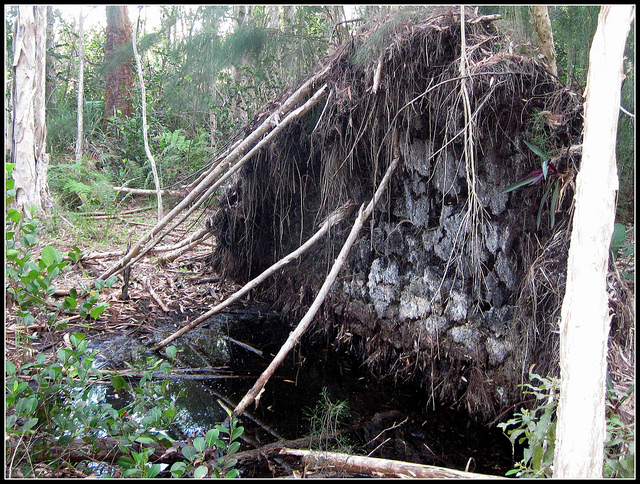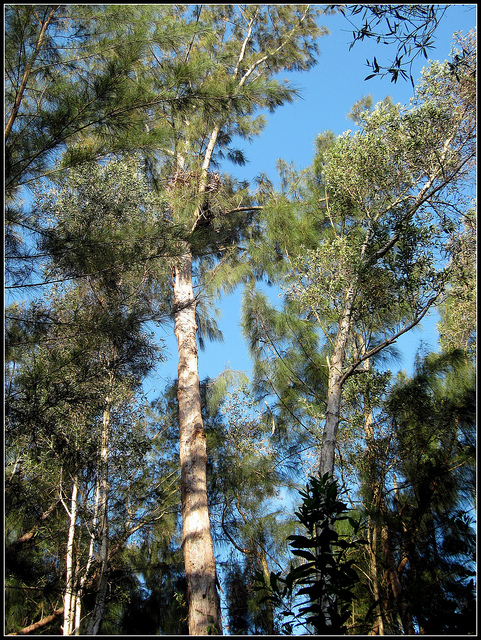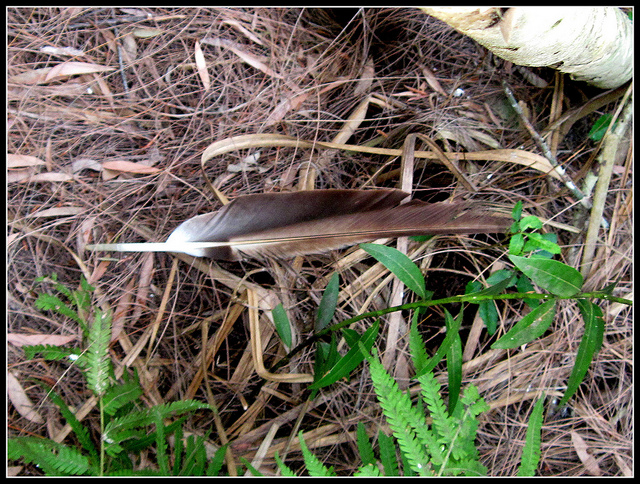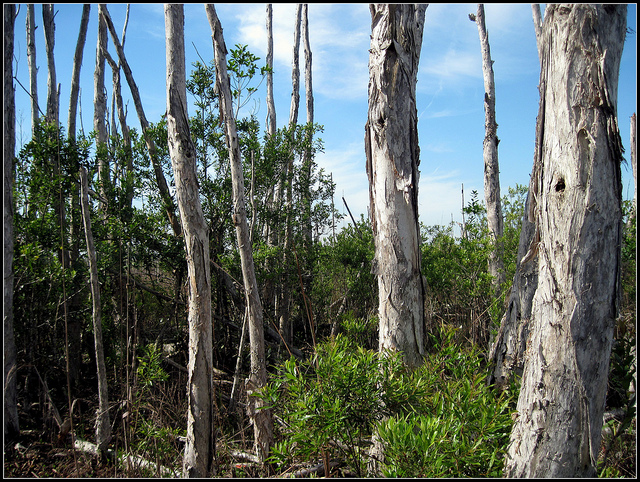Bald Eagles of Broward County, Florida
› ARCHIVED Pembroke Pines OBSERVATIONS & PHOTOS FROM PRIOR NESTING SEASONS
›
ARCHIVED 2011-2012 Nesting Season Observations and Photos
Unsuccessful search for missing eaglet this morning MAR 30
Unsuccessful search for missing eaglet this morning MAR 30
|
Administrator
|
This post was updated on .
Yesterday I called the Florida Fish & Wildlife Conservation Commission (FWC) hotline to report our concerns. Since it was not considered an emergency, they put me in contact with Michelle Van Deventer, FWC Bald Eagle Coordinator (see my post from yesterday). After considering that the eaglet very likely had not survived, Michelle authorized me to investigate under the nest. Her instructions were that if we discovered any eagle remains, we were not to touch them and instead call FWC, as a forensic examination would need to be conducted to determine the cause of death.
I had earlier obtained permission from the City of Pembroke Pines to enter the nest area, and notified the head of Public Works of my intention to walk out to the nest the next morning (today). Al Griffin and I arrived in the area of the nest before 8:00 AM this morning. As has been the case, neither adult nor young Bald Eagles were seen or heard. Al had already set up two ladders that provided a way to get over the fence directly in front of the nest tree. He also had a small chain saw which allowed us to get through the tangle of Melaleuca saplings, Brazilian Pepper shrubs and vines that are especially thick at the edge of the wooded property.   This is a view looking north, back towards Pines Boulevard. The greater amount of light really encourages the dense growth at the margins of the woodland.  We had to hack our way about 20 yards before entering a more open area populated by larger Melaleucas and Sawgrass. There were areas of standing water and mud, but the area immediately around the nest tree was somewhat clearer. By chance, Trisha showed up and was able to retrieve a machete from Al's truck, which also came in handy.  There was much evidence of animal activity in the immediate area of the nest. One straight and well-worn track looked like an alligator trail to Al. Other trails wound around the nest tree and the trunks of nearby trees. We found three burrows that looked as if they were currently used dens of medium-sized mammals. Raccoons? We saw no tracks as the ground was covered in leaves and pine needles.   We carefully searched a circular area about 50 feet around the nest, and found many prey remains-- feathers of white and black and white birds, probably adult and immature White Ibis, and possibly egrets. A few feathers were white with brightly iridescent black areas that may have come from a Wood Stork or possibly a Muscovy Duck. However, there was no evidence of a dead eaglet. Nearly all the contour feather we found were white, and they were more concentrated to the west of the nest tree, not surprising in view of the prevalent easterly winds. This is a view of the nest tree from the side opposite the road.   One large feather was of particular interest. Was it possibly an eagle feather, and could it have come from the eaglet? If the latter, it certainly could not have been shed naturally (molted) at such a young age. We have not seen signs of molt in the adult birds, but the feather appeared undamaged, unlike the other feathers, some of which were attached to flesh. This feather did not look like one that had been torn out by a predator or scavenger.  It was a fresh-looking primary flight quill, 16 3/4 inches (42 cm) long and up to 2 1/4 inch (6 cm) wide, dark brown on the top and bottom, located about 10 feet east of the base of the nest tree. Both the top (dorsal) and the bottom (ventral) surfaces of the feather followed the same pattern. The dorsal surface of the feather shaft was brown, while the underside of the shaft was white. The base of the feather had white downy tufts. Past the white area, the mid portion of the narrower leading edge had a dark brown band that measured about 1 1/2 inches (3.5 cm). The mid portion of the remaining (distal) leading edge was lighter brown, with a 4 inch darker brown area at the feather tip. The vanes of the trailing edge matched the dark brown areas of the leading edge, but the base of the vanes nearest the middle of the shaft were the same light brown color as those on the opposite (leading edge). There was no barring. I believe that the leading edge, particularly, showed sign of wear, something we would not expect to see if it came from a newly fledged eaglet. We will ask experts for help in identifying the feather. After about two hours of searching the nest area, three police patrol cars showed up, lights flashing. Phil, bicycling by the nest as he often does, had called them after seeing our vehicles and hearing us in the woods. Al and Trisha handled he cops while I worked my way to the southwest, generally following areas with more feathers. This brought me into the heart of the stand of herbicide-killed Melaleuca trunks where the eagles often roost. It also provided a panoramic view of the west side of the "eagle forest." I scanned the treetops for signs of the eaglet, as we did a couple of years ago when one went missing and we found it "tree-hopping" back to the nest. No luck, and likewise the areas around the larger and favored roost trees were clear.  Al joined me there and we concluded our search and drank some of his delightfully cold water. 
Ken Schneider
Web site: http://rosyfinch.com Blog: http://rosy-finch.blogspot.com Photos: <http://flickr.com/photos/rosyfinch> |
Re: Unsuccessful search for missing eaglet this morning MAR 30
|
Administrator
|
This post was updated on .
Looking again at that feather, I am convinced it is an old one from an adult, recently molted. The light areas are bleached by the sun. The more proximal ("root") end of the feather retains rich dark pigment as it probably was protected by wing coverts. The leading edge shows the greatest degree of wear and bleaching. Not sure why the very tip of the feather is dark, but perhaps the ends of the primaries are tucked away when the bird is roosting.
Still not positive it is from the Bald Eagle. I have seen Turkey Vulture primaries that were quite long, but don't think they were 17 inches long. Can't think of any other possibility around here. If it is an eagle feather, I would like to contribute it to a Native American official before it deteriorates in the elements. FWC does not want to retrieve it because there is no carcass and no complaint or evidence of foul play. This photo of one of the adults shows how the outermost 12 or 13 (primary) flight feathers are arranged. Note that the outer 5 or 6 feathers (arising from the fingers of the "hand," and often called pinions) are particularly long and pointed. The others become more rounded at the tip. The next row of feathers (secondaries) are shorter and more regular in pattern. When the wing is closed, each outermost feather covers the one closer to the body, thus shading the trailing edge of the feather. This accounts for the bleaching of the leading edge of the feather as seen in the one I photographed under the eagle nest. It probably is one of the longest of the pinions 
Ken Schneider
Web site: http://rosyfinch.com Blog: http://rosy-finch.blogspot.com Photos: <http://flickr.com/photos/rosyfinch> |
«
Return to ARCHIVED 2011-2012 Nesting Season Observations and Photos
|
1 view|%1 views
| Free forum by Nabble | Edit this page |

